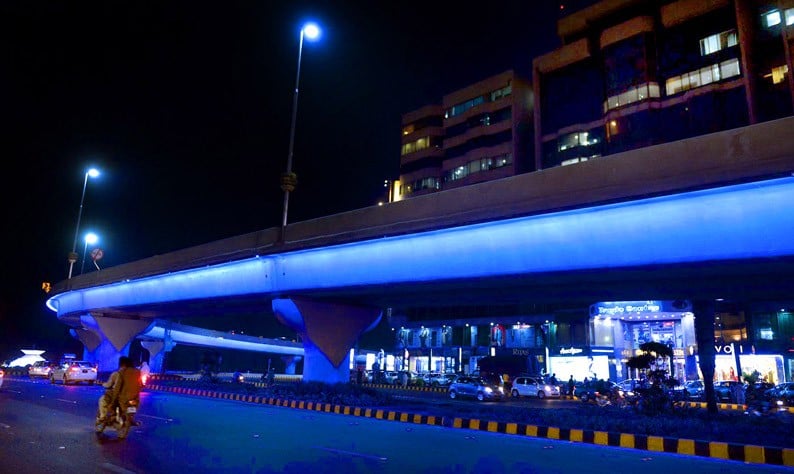
The under-belly of Lahore under its many bridges

There is between two adjoining arches, where the outer curves meet, always a triangular space called a spandrel. I’ll give you a second to imagine it (or, if you’re like me, google it). This unintended by-product is an indispensable consequence, a logical necessity. The two must occur together. In quite the same way, every time a bridge is built, though it connects two localities, it also begets a life that dwells underneath it.
In the murky shadows underneath the Jinnah Flyover in Lahore, I have found that life to be abundant.
From atop the bridge, if you careen your neck from side to side, you see that Lahore is rising. If the moonlight permits, you can always point out a crane or two in the distance. Standing there you see at once the beauty mark and the blemish; the fancy boutique hotel to your right, and the not-so-fancy plagiarism that has sprung in its wake (such as, my favourite, the Punjab Continental).
But look higher yet, above the bustling traffic, and you perceive after a moment the eyes of Fawad Khan. They are brown and gigantic -- their retinas one foot wide. Beside him is an image of a beverage at a discounted price. Like the billboard of that ominous oculist from that most famous of F. Scott Fitzgerald’s novels, the paint over Fawad’s eyes has been dimmed by the not-so-recent monsoon. But look not at what the advertisers want you to, follow instead his gaze and it will take you under the bridge.
The road there is rickety, yes rickety. Years and years of vibrations caused by the coming and going of trains have rendered it almost grainy.
At rush hour you can be stuck quite literally between a train and a donkey cart. And without fail there is a wagon-wala going against the traffic, with that particular and arrogant confidence that only a Chaudhry can command in his village. He will impede your path, and just at the moment you lower your window to give him a mouthful, remember my words -- you should’ve just taken the bridge.
After the sun fully sets, a slew of tiny little shops come to life. These must surely represent the cheapest real estate (accessible by a metal road) in all of Gulberg. They seem to be pushing against each other, like an obtuse belly raging against a belt buckle, one rung too tight, fighting for space to breathe. There isn’t much creativity of product as almost all of them are selling second-hand tires. The range goes from tires for bicycles all the way up to ones for rickshaws. Again, if you own an automobile of a higher order, I repeat -- you should’ve just taken the bridge.
If memory serves I swear I saw a travel agency sandwiched in between the tire shops. The owner must be an entrepreneur of the highest order, for he is endeavouring to create a market for himself here. One would think the five old men that sit on the other side of the road from him playing cards on the curb are not his ideal clientele. Who knows maybe there is a trip to paradise in the offing, but I wouldn’t take the risk; there are easier ways to die.
But once the dust settles and the neon lights sprinkle down from the hoardings up top, Fawad’s large besotting eyes must bear witness to tiny acts of wickedness, too. For surely under the bridge must reside the under-belly of Lahore as well.
Take it from me, gone are those days. The world under this bridge is far too public, teeming with people as it is, for an exchange of merry goods, or lovers on the run to go unnoticed. And now that the Ring Road has almost fully encircled Lahore it is far easier to find a quiet spot there.
Though there must be prostitution, gambling and drug use under the bridge, and one does hear about such things, it is not as Dickensian as our imaginations would have it be. All of that can be found equally behind high-gated compounds as well as under the naked night sky. The world under the bridge might simply lack the door behind which the rest of us hide our base impulses, if one should even call them that.
What you find here instead are the homeless and the abandoned. A card game here and there, and a few snores to while away the time. There isn’t much else that goes on under a bridge after the shutters to the shops come down; just the erratic hum-drum of a truck trudging along up above, or a dog howling in the distance.
It gets quite serene just before dawn, hours before those who were sleeping wake up, when fruit vendors start setting up their stalls. Quietly, trucks carrying dry fruits from Chakwal and citrus from Swat come and go. Under the brightly coloured LED lights there are at least twenty men carefully arranging the supplest of their product neatly to attract the first customers of the day.
A young boy among the vendors cranes his neck upwards and looks straight into the bewitching stare of Fawad Khan and says to his brother, "Ae sab kuch venda ae!" (He sees everything). His elder brother, annoyed at this needless philosophical musing, assures him, "Ae mashhoori da phatta ae." (That’s an advertisement). The young boy rolls his eyes and returns to dusting the fruit.